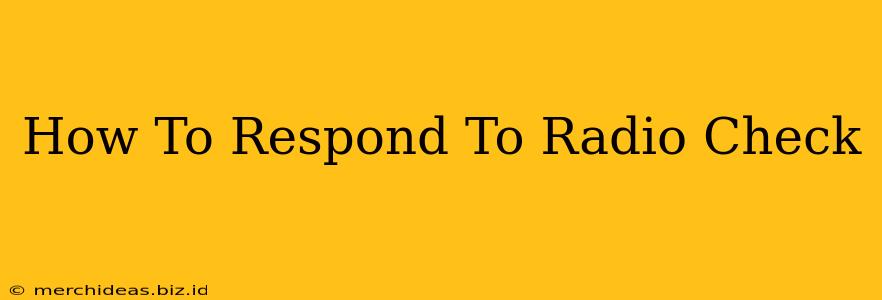Maintaining clear and concise communication is critical in any operation that relies on two-way radios, whether it's construction, emergency services, or security. A radio check is a simple yet vital procedure to ensure your radio is functioning correctly and your transmission is being received. Knowing how to respond properly is crucial for efficient teamwork and safety. This guide will cover the various ways to respond to a radio check, and the best practices for ensuring effective communication.
Understanding the Purpose of a Radio Check
Before diving into responses, let's understand why radio checks are essential. A radio check verifies:
- Radio Functionality: It confirms that your radio is transmitting and receiving signals effectively.
- Signal Strength: It gives an indication of the signal strength between different radios.
- Channel Clarity: It helps identify any interference or static affecting communication.
- Team Readiness: It ensures everyone on the team is monitoring the correct channel and their radios are operational.
How to Respond to a Radio Check: Different Scenarios
The ideal response to a radio check depends on the context and the specific communication protocols in place. However, some common and effective responses include:
1. The Standard Response:
This is the simplest and most widely used response. When someone calls out "Radio check," you simply reply:
"Radio check, (your callsign/name/identifier)."
For example:
- Caller: "Radio check"
- Response: "Radio check, Unit Alpha 1" or "Radio check, John."
This straightforward response confirms that your radio is functioning and provides identification. Keep it concise and clear.
2. Adding Signal Strength Information (If Applicable):
In some environments, especially those with potentially weaker signals, adding a signal strength assessment is beneficial. You can say:
"Radio check, (your callsign/name/identifier), signal (strong/good/weak/unreadable)."
For example:
- Caller: "Radio check."
- Response: "Radio check, Unit Bravo 2, signal strong."
This additional information helps the other party assess the overall communication quality.
3. Responding to Specific Questions in a Radio Check:
Sometimes a radio check might be more involved, such as:
- Caller: "Radio check, Unit Alpha 1, can you copy?"
- Response: "Copy, Unit Alpha 1, loud and clear."
This type of response confirms you received the original transmission.
- Caller: "Radio Check, what's your location?"
- Response: "Radio Check, this is Unit 3, located at the North Gate."
Here, you provide the requested information efficiently and clearly.
Best Practices for Radio Communication
Regardless of the specific response you choose, adhere to these crucial best practices:
- Speak Clearly and Concisely: Avoid slang, jargon, or overly long sentences.
- Use Your Assigned Callsign/Identifier: This helps avoid confusion and ensures proper identification.
- Listen Before Transmitting: Avoid interrupting other transmissions.
- Be Aware of Your Surroundings: Reduce background noise as much as possible.
- Repeat Back Important Information: Confirming key instructions prevents misunderstandings.
- Use Standard Operating Procedures (SOPs): Follow established protocols within your organization for radio communication.
Conclusion: Effective Communication Saves Time and Prevents Mishaps
Mastering the art of responding to a radio check is fundamental for efficient and safe communication. By using clear, concise language and adhering to best practices, you can ensure that your team can rely on your radio communication to coordinate actions and respond to situations effectively. Remember to tailor your response to the specific context and always prioritize safety and efficiency.
